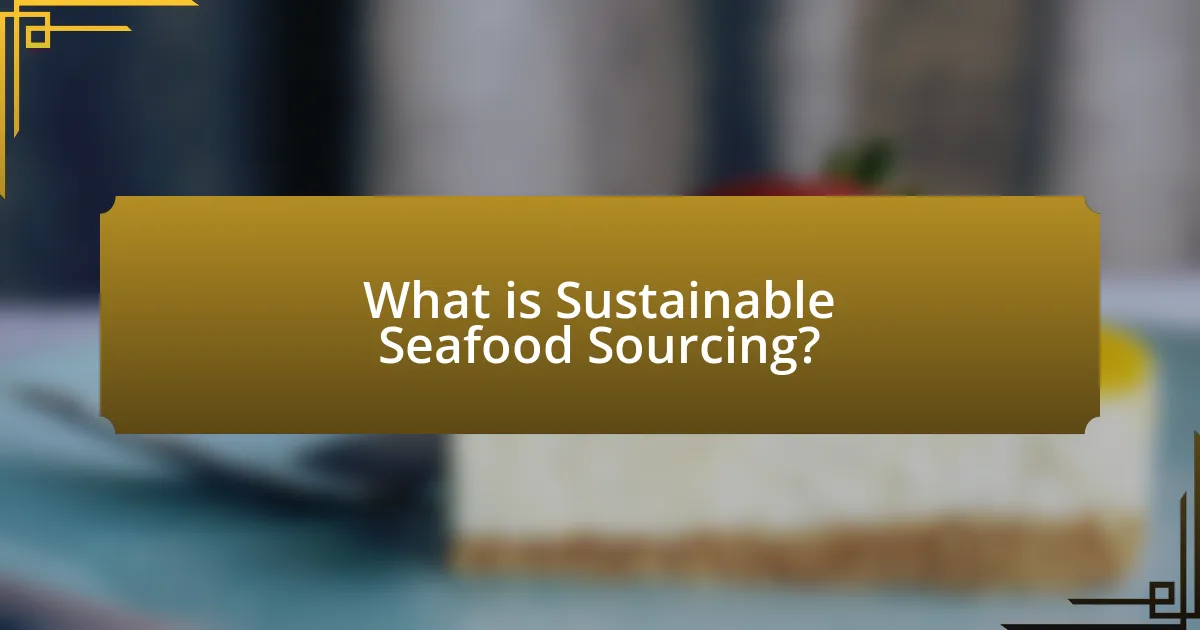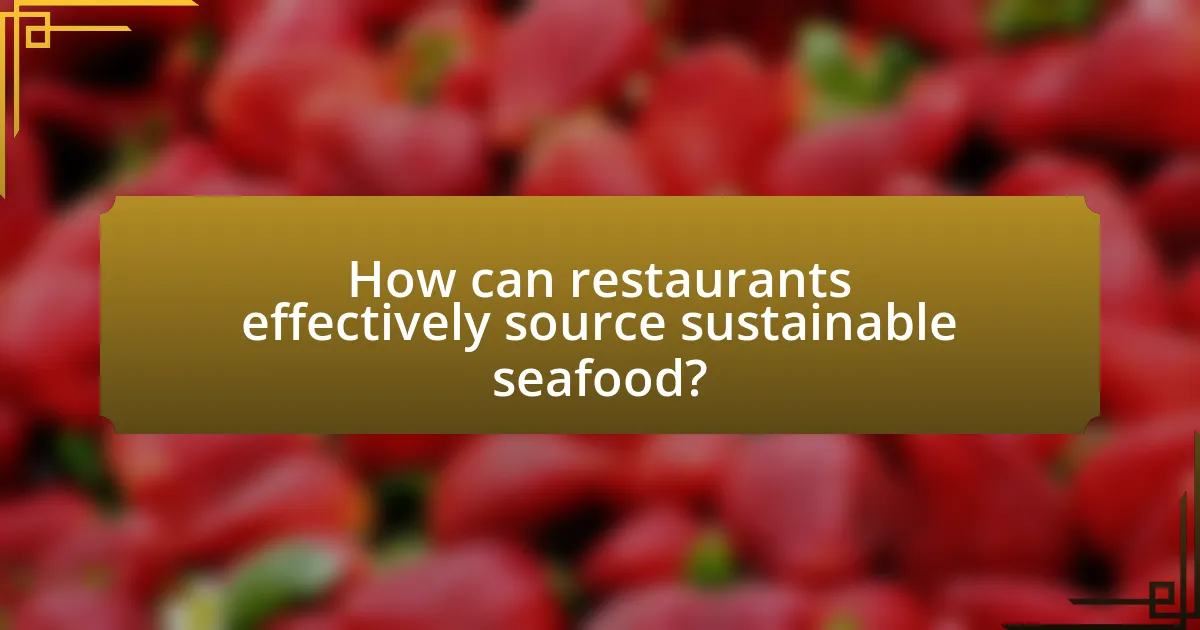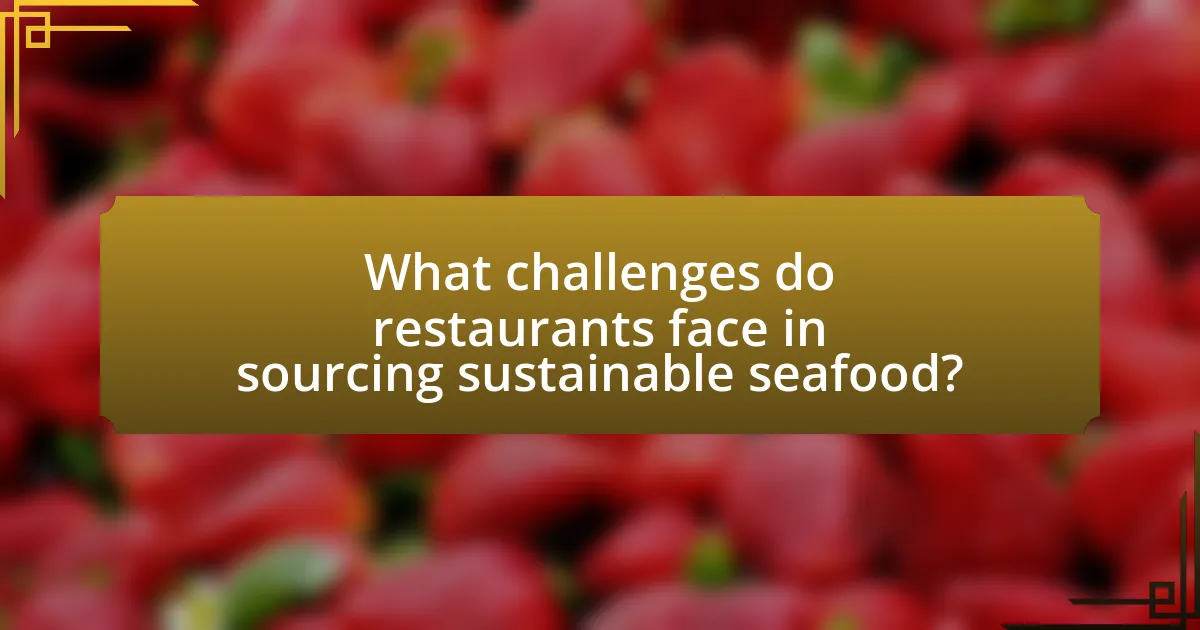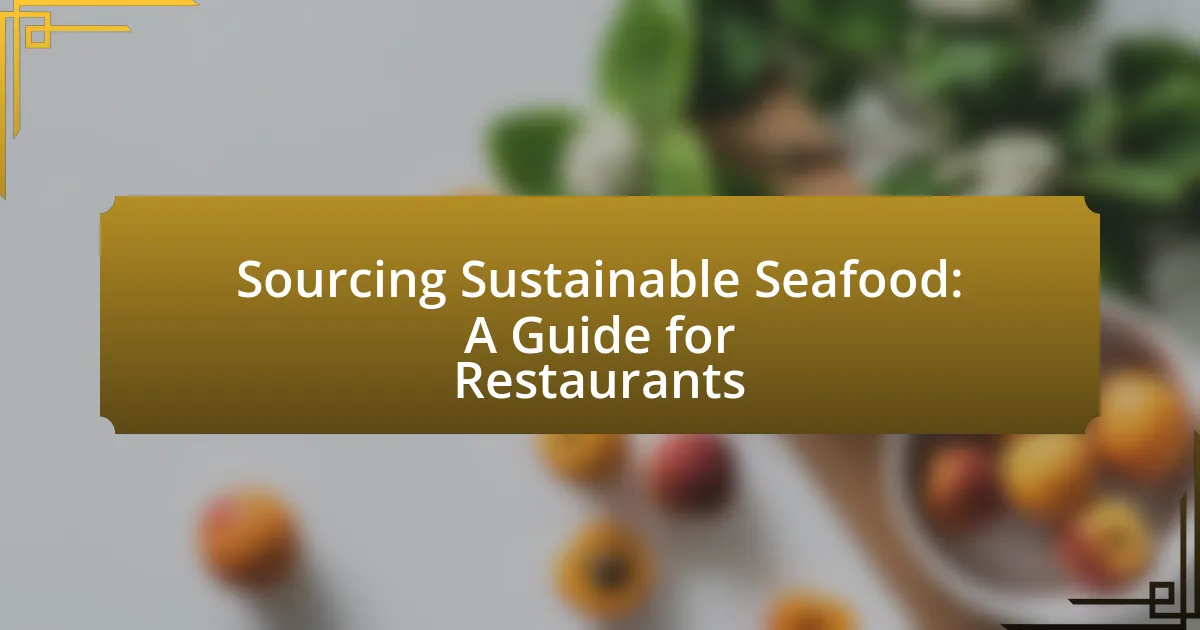Sourcing sustainable seafood is a critical practice for restaurants aimed at maintaining healthy fish populations and marine ecosystems. This article outlines the importance of sustainable seafood sourcing, highlighting its benefits for restaurants, including enhanced brand reputation and customer loyalty. It discusses the environmental impacts of unsustainable practices, criteria for defining sustainable seafood, and effective strategies for sourcing, including partnerships with certified suppliers and local fisheries. Additionally, the article addresses common misconceptions, logistical challenges, and best practices for minimizing waste and educating staff and customers about sustainable seafood options.

What is Sustainable Seafood Sourcing?
Sustainable seafood sourcing refers to the practice of obtaining seafood from fisheries and aquaculture operations that maintain healthy fish populations and ecosystems. This approach ensures that seafood is harvested in a way that does not compromise the ability of future generations to meet their needs. According to the Marine Stewardship Council, sustainable seafood sourcing involves adhering to guidelines that promote responsible fishing practices, such as avoiding overfishing, minimizing bycatch, and protecting marine habitats. This method not only supports environmental health but also contributes to the economic viability of fishing communities.
Why is sustainable seafood important for restaurants?
Sustainable seafood is important for restaurants because it ensures the long-term viability of fish populations and marine ecosystems. By sourcing seafood that is harvested responsibly, restaurants contribute to the preservation of biodiversity and help combat overfishing, which affects approximately 34% of global fish stocks according to the Food and Agriculture Organization. Additionally, offering sustainable seafood can enhance a restaurant’s reputation, attract environmentally conscious consumers, and potentially increase profitability, as 66% of consumers are willing to pay more for sustainable options.
What are the environmental impacts of unsustainable seafood sourcing?
Unsustainable seafood sourcing leads to significant environmental impacts, including overfishing, habitat destruction, and biodiversity loss. Overfishing depletes fish populations faster than they can reproduce, resulting in a decline of species such as cod and tuna, which has been documented by the Food and Agriculture Organization, indicating that 34% of global fish stocks are overfished. Habitat destruction occurs through practices like bottom trawling, which damages ocean floors and disrupts ecosystems, as reported by the National Oceanic and Atmospheric Administration. Additionally, unsustainable practices contribute to the extinction of marine species, with the International Union for Conservation of Nature noting that one in four marine species is threatened. These impacts collectively undermine marine ecosystems and the livelihoods of communities dependent on fishing.
How does sustainable seafood sourcing benefit restaurant businesses?
Sustainable seafood sourcing benefits restaurant businesses by enhancing their brand reputation and attracting environmentally conscious consumers. Restaurants that prioritize sustainability can differentiate themselves in a competitive market, leading to increased customer loyalty and potentially higher sales. According to a 2021 study by the Marine Stewardship Council, 66% of consumers are willing to pay more for sustainably sourced seafood, indicating a strong market demand. Additionally, sustainable practices can lead to long-term cost savings by ensuring a stable supply of seafood and reducing the risk of overfishing, which can disrupt supply chains.
What criteria define sustainable seafood?
Sustainable seafood is defined by criteria that ensure fish and shellfish are harvested in a way that maintains healthy populations and ecosystems. Key criteria include the use of fishing methods that minimize environmental impact, adherence to regulations that prevent overfishing, and sourcing from fisheries that are certified by recognized sustainability standards, such as the Marine Stewardship Council. These practices help ensure that seafood is not only abundant but also supports the long-term health of marine environments.
How do fishing methods affect sustainability?
Fishing methods significantly affect sustainability by determining the impact on fish populations and marine ecosystems. For instance, methods like trawling can lead to overfishing and habitat destruction, while sustainable practices such as pole-and-line fishing minimize bycatch and preserve marine habitats. According to the Food and Agriculture Organization, approximately 34% of global fish stocks are overfished, highlighting the urgent need for sustainable fishing practices to maintain ecological balance and ensure long-term fish availability.
What role do aquaculture practices play in sustainability?
Aquaculture practices play a crucial role in sustainability by providing a controlled environment for fish and seafood production, which reduces overfishing in wild populations. These practices can enhance food security and support local economies while minimizing environmental impacts through responsible management techniques. For instance, sustainable aquaculture methods, such as integrated multi-trophic aquaculture, utilize waste from one species as nutrients for another, thereby promoting ecosystem balance. According to the Food and Agriculture Organization, aquaculture accounted for 46% of global fish consumption in 2020, highlighting its importance in meeting the growing demand for seafood without depleting natural resources.

How can restaurants effectively source sustainable seafood?
Restaurants can effectively source sustainable seafood by partnering with certified suppliers who adhere to recognized sustainability standards, such as those set by the Marine Stewardship Council (MSC) or the Aquaculture Stewardship Council (ASC). These certifications ensure that seafood is harvested or farmed in ways that maintain healthy fish populations and ecosystems. Additionally, restaurants can utilize resources like the Seafood Watch program, which provides guidance on sustainable seafood choices based on environmental impact. By prioritizing these practices, restaurants contribute to the conservation of marine resources and promote responsible sourcing.
What steps should restaurants take to identify sustainable seafood suppliers?
Restaurants should conduct thorough research to identify sustainable seafood suppliers. This involves verifying suppliers’ certifications, such as those from the Marine Stewardship Council or the Aquaculture Stewardship Council, which indicate adherence to sustainable practices. Additionally, restaurants should engage with local fisheries and aquaculture operations to understand their sustainability practices and sourcing methods. Utilizing resources like the Seafood Watch program can provide valuable insights into sustainable seafood choices. Furthermore, establishing direct communication with suppliers to inquire about their sourcing practices and environmental impact is essential. This multi-faceted approach ensures that restaurants can confidently source seafood that aligns with sustainability standards.
How can restaurants verify the sustainability claims of suppliers?
Restaurants can verify the sustainability claims of suppliers by conducting thorough audits and requiring third-party certifications. Audits involve assessing the supplier’s practices, including sourcing methods and environmental impact, while third-party certifications, such as those from the Marine Stewardship Council or the Aquaculture Stewardship Council, provide independent verification of sustainability standards. These certifications are based on established criteria that evaluate the ecological health of fisheries and aquaculture operations, ensuring that suppliers adhere to responsible practices.
What certifications should restaurants look for in seafood products?
Restaurants should look for certifications such as the Marine Stewardship Council (MSC) certification, the Aquaculture Stewardship Council (ASC) certification, and the Best Aquaculture Practices (BAP) certification when sourcing seafood products. The MSC certification indicates that wild-caught seafood is sourced from sustainable fisheries, while the ASC certification ensures that farmed seafood is produced responsibly, minimizing environmental impact. The BAP certification covers various aspects of aquaculture, including environmental and social responsibility, ensuring that seafood is produced in a sustainable manner. These certifications are recognized globally and provide assurance that seafood products meet high sustainability standards.
How can restaurants build relationships with sustainable seafood suppliers?
Restaurants can build relationships with sustainable seafood suppliers by prioritizing transparency and communication. Establishing open lines of dialogue allows restaurants to understand the sourcing practices and sustainability certifications of their suppliers, ensuring alignment with their values. Regular visits to suppliers’ facilities can further strengthen these relationships, providing firsthand insight into their operations and commitment to sustainability. Additionally, participating in industry events and forums focused on sustainable seafood can foster networking opportunities, enabling restaurants to connect with like-minded suppliers. Research indicates that restaurants that engage in these practices not only enhance their supply chain reliability but also contribute to the overall sustainability of the seafood industry.
What are the benefits of direct sourcing from local fisheries?
Direct sourcing from local fisheries provides numerous benefits, including fresher seafood, support for local economies, and reduced environmental impact. Freshness is achieved as seafood is harvested and delivered quickly, often within hours, ensuring higher quality and better taste. Supporting local economies fosters community resilience, as funds circulate within the region, benefiting fishermen and related businesses. Additionally, sourcing locally minimizes transportation emissions, contributing to a lower carbon footprint, which aligns with sustainable practices. Studies indicate that local sourcing can reduce food miles by up to 90%, significantly decreasing greenhouse gas emissions associated with transportation.
How can restaurants collaborate with suppliers for better sustainability practices?
Restaurants can collaborate with suppliers for better sustainability practices by establishing clear communication and shared goals focused on environmental impact. This collaboration can involve sourcing seafood from suppliers who adhere to sustainable fishing practices, such as those certified by the Marine Stewardship Council, which ensures that seafood is harvested in a way that maintains healthy fish populations and ecosystems. Additionally, restaurants can engage in joint initiatives with suppliers to reduce waste, such as implementing a system for utilizing bycatch or unsold seafood, thereby minimizing environmental footprints. Research indicates that partnerships between restaurants and suppliers that prioritize sustainability can lead to improved supply chain transparency and enhanced consumer trust, ultimately benefiting both parties economically and environmentally.

What challenges do restaurants face in sourcing sustainable seafood?
Restaurants face significant challenges in sourcing sustainable seafood, primarily due to the complexity of supply chains and varying sustainability standards. The seafood industry is often characterized by overfishing, illegal fishing practices, and a lack of transparency, making it difficult for restaurants to verify the sustainability of their seafood sources. According to the Marine Stewardship Council, only about 10% of global fisheries are certified as sustainable, which limits the options available to restaurants. Additionally, fluctuating market prices and inconsistent availability of sustainable seafood can hinder restaurants’ ability to maintain a reliable supply. These factors create obstacles for restaurants striving to meet consumer demand for environmentally responsible dining options.
What are the common misconceptions about sustainable seafood sourcing?
Common misconceptions about sustainable seafood sourcing include the belief that all farmed seafood is unsustainable, that sustainability labels guarantee eco-friendliness, and that wild-caught seafood is always better than farmed. Many assume that all farmed seafood harms the environment; however, responsible aquaculture practices can reduce overfishing and habitat destruction. Additionally, sustainability certifications, such as those from the Marine Stewardship Council, do not always reflect the entire supply chain’s impact, leading to potential misinterpretations. Lastly, while wild-caught seafood can be sustainable, it often depends on the fishing methods used and the management of fish stocks, which can vary significantly.
How can restaurants overcome the perception of higher costs associated with sustainable seafood?
Restaurants can overcome the perception of higher costs associated with sustainable seafood by effectively communicating the long-term benefits and value of sustainability to their customers. By highlighting the health benefits of sustainable seafood, such as lower levels of contaminants and higher omega-3 fatty acids, restaurants can justify the price difference. Additionally, showcasing the environmental impact of choosing sustainable options, such as supporting local fisheries and reducing overfishing, can resonate with eco-conscious consumers.
Evidence from a 2021 study published in the Journal of Sustainable Seafood indicates that 70% of consumers are willing to pay more for seafood that is certified sustainable, demonstrating that effective marketing and education can shift perceptions. Furthermore, restaurants can implement menu strategies that emphasize the quality and unique flavors of sustainable seafood, thereby enhancing the dining experience and justifying the cost.
What logistical challenges do restaurants encounter when sourcing sustainable seafood?
Restaurants encounter several logistical challenges when sourcing sustainable seafood, including supply chain complexity, fluctuating availability, and compliance with regulations. The supply chain for sustainable seafood often involves multiple stakeholders, such as fishermen, distributors, and certification bodies, which can complicate procurement processes. Additionally, the availability of sustainable seafood can vary seasonally and geographically, making it difficult for restaurants to maintain a consistent menu. Compliance with various regulations, such as those related to sustainability certifications and traceability, adds another layer of complexity, requiring restaurants to invest time and resources to ensure they meet these standards.
How can restaurants educate their staff and customers about sustainable seafood?
Restaurants can educate their staff and customers about sustainable seafood through comprehensive training programs and informative materials. Implementing regular staff training sessions that cover the importance of sustainable seafood, including its environmental impact and benefits, ensures that employees are knowledgeable and can communicate effectively with customers. Additionally, providing customers with educational resources such as brochures, menu labels indicating sustainable options, and hosting events focused on sustainable seafood practices can enhance awareness. Research from the Marine Stewardship Council indicates that informed consumers are more likely to choose sustainable options, demonstrating the effectiveness of these educational initiatives.
What training programs can help staff understand sustainable seafood sourcing?
Training programs that can help staff understand sustainable seafood sourcing include the Seafood Watch program by the Monterey Bay Aquarium, which provides resources and training on sustainable seafood choices. Additionally, the Marine Stewardship Council offers training on sustainable fishing practices and certification processes. The National Oceanic and Atmospheric Administration (NOAA) also provides educational resources and workshops focused on sustainable seafood sourcing. These programs are validated by their widespread use in the industry and their alignment with best practices in sustainable sourcing.
How can restaurants effectively communicate their sustainable seafood practices to customers?
Restaurants can effectively communicate their sustainable seafood practices to customers by prominently displaying certifications and sourcing information on menus and signage. This transparency allows customers to understand the origins of the seafood, such as whether it is sourced from certified sustainable fisheries or farms. For instance, the Marine Stewardship Council (MSC) and the Aquaculture Stewardship Council (ASC) provide recognizable labels that indicate adherence to sustainability standards. Additionally, engaging staff in training about sustainable practices enables them to confidently share this information with customers, enhancing the dining experience and fostering trust. Research shows that 66% of consumers are willing to pay more for sustainable seafood, indicating that clear communication can positively impact customer choices and restaurant reputation.
What are some best practices for sourcing sustainable seafood?
Best practices for sourcing sustainable seafood include selecting seafood certified by reputable organizations such as the Marine Stewardship Council (MSC) or the Aquaculture Stewardship Council (ASC). These certifications ensure that the seafood is harvested or farmed in ways that maintain healthy fish populations and minimize environmental impact. Additionally, restaurants should prioritize local seafood to reduce carbon footprints associated with transportation and support local economies. Engaging with suppliers who can provide transparency about their sourcing practices and the sustainability of their products is also crucial. Research indicates that overfishing affects 34% of global fish stocks, highlighting the importance of responsible sourcing to protect marine ecosystems.
How can restaurants incorporate seasonal seafood into their menus?
Restaurants can incorporate seasonal seafood into their menus by sourcing fish and shellfish that are at their peak availability during specific times of the year. This approach not only enhances flavor and freshness but also supports sustainable fishing practices. For example, many species, such as salmon, are best consumed in the summer months when they are abundant, while others like cod are more plentiful in winter. By aligning menu offerings with the seasonal availability of seafood, restaurants can reduce their environmental impact and promote local fisheries. According to the Marine Stewardship Council, seasonal seafood sourcing can lead to a 30% increase in sustainability ratings for restaurants, demonstrating the positive impact of this practice on both the environment and business reputation.
What strategies can restaurants use to minimize waste when sourcing seafood?
Restaurants can minimize waste when sourcing seafood by implementing strategies such as establishing partnerships with local fisheries, utilizing whole fish, and adopting just-in-time inventory practices. Establishing partnerships with local fisheries allows restaurants to receive fresher seafood, reducing spoilage and waste. Utilizing whole fish encourages the use of all parts of the fish, which can be transformed into various dishes, thereby minimizing waste. Adopting just-in-time inventory practices helps restaurants order seafood based on actual demand, reducing the likelihood of over-purchasing and subsequent waste. These strategies are supported by the fact that the seafood industry is responsible for significant waste, with estimates suggesting that up to 30% of seafood is discarded due to spoilage or overfishing practices.

Leave a Reply